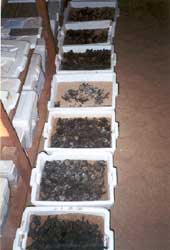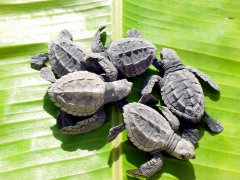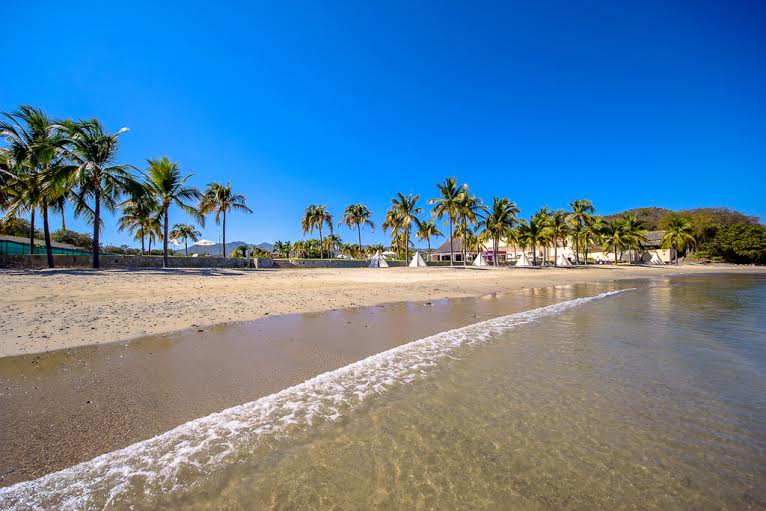- By Desiree Bilon
Endangered Sea Turtles
 Although Olive Ridley might sound like the name of a children’s storybook character, it is the actually the name of a species of sea turtle in trouble. The Olive Ridley takes it name from the grey-green color of its heart-shaped shell. Even though this is one of the most abundant species of turtles in the world, it is still considered an endangered species on the Pacific coast of Mexico where the Riviera Nayarit is located.
Although Olive Ridley might sound like the name of a children’s storybook character, it is the actually the name of a species of sea turtle in trouble. The Olive Ridley takes it name from the grey-green color of its heart-shaped shell. Even though this is one of the most abundant species of turtles in the world, it is still considered an endangered species on the Pacific coast of Mexico where the Riviera Nayarit is located.
The second smallest of the sea turtles, after the Kemp Ridley, Olive Ridleys weigh between 75-100 pounds (34 – 45 kg) and reach 2-2 ½ feet (0.6-0.75 m) in length. Mostly omnivorous, this turtle lives off a diet of crabs, jellyfish, lobster, and shrimp. Commercial fishing, loss of nesting habitat, and climate change are among the human-induced threats to turtle population levels worldwide.
 The Olive Ridley has a number of natural predators. In San Francisco (San Pancho), a small town one hour north of Puerto Vallarta on Mexico’s Pacific coast, the domestic dog is the largest predator, digging up turtle eggs. Human poachers are also known to gather turtle eggs while the female is depositing them into the sand, only later to resell the eggs – considered an aphrodisiac in Mexico. If the eggs do remain in the sand, fly larvae pose the greatest threat to the nests. Once the turtles have hatched, ghost crabs become the new predators, going after the baby turtles and tucking them into their sand holes.
The Olive Ridley has a number of natural predators. In San Francisco (San Pancho), a small town one hour north of Puerto Vallarta on Mexico’s Pacific coast, the domestic dog is the largest predator, digging up turtle eggs. Human poachers are also known to gather turtle eggs while the female is depositing them into the sand, only later to resell the eggs – considered an aphrodisiac in Mexico. If the eggs do remain in the sand, fly larvae pose the greatest threat to the nests. Once the turtles have hatched, ghost crabs become the new predators, going after the baby turtles and tucking them into their sand holes.
Sea Turtle Rescue
Frank Smith, a US expatriate, who has dedicated his life to turtle conservation, founded the Grupo Ecológico de la Costa Verde, A.C. in 1992. The “group” built the first marine nursery in San Pancho, Nayarit to help increase turtle numbers. Sea turtles, even though diminished in population, play a key role in oceanic ecosystems. They are vital in maintaining healthy sea grass beds and coral reef, which provide habitat for other marine life; help balance marine food webs; and help facilitate nutrient cycling from water to land.
 Frank stays up every night until 4:00 am and then sleeps until noon. From the end of June until mid-November, he is out collecting nests. Two teams, 3-4 people each, take turns searching for nests. One team goes from 10:00 pm until 1:00 am and the next team goes from 1:00 am to 6:00 am. They look for turtle tracks in the sand, approximately 2-feet wide (about 0.6 meters wide), and then follow them up to the nest sites. Once the female has finished depositing her eggs, and leaves, the team retrieves the nest.
Frank stays up every night until 4:00 am and then sleeps until noon. From the end of June until mid-November, he is out collecting nests. Two teams, 3-4 people each, take turns searching for nests. One team goes from 10:00 pm until 1:00 am and the next team goes from 1:00 am to 6:00 am. They look for turtle tracks in the sand, approximately 2-feet wide (about 0.6 meters wide), and then follow them up to the nest sites. Once the female has finished depositing her eggs, and leaves, the team retrieves the nest.
Sea Turtle Nurseries
 Two types of nurseries are used in San Pancho. One is the beach nursery where eggs are buried into a fenced off area in the sand, simulating a more natural habitat. The second is the “box” nursery. By replicating commercial hatcheries, carefully selected sand is placed into a styrofoam box and kept in a semi-heated room. The eggs are placed into the sand in neat rows, as opposed to a bunch of eggs dumped into a hole. Survival rates in the box nursery are successful, around 89%.
Two types of nurseries are used in San Pancho. One is the beach nursery where eggs are buried into a fenced off area in the sand, simulating a more natural habitat. The second is the “box” nursery. By replicating commercial hatcheries, carefully selected sand is placed into a styrofoam box and kept in a semi-heated room. The eggs are placed into the sand in neat rows, as opposed to a bunch of eggs dumped into a hole. Survival rates in the box nursery are successful, around 89%.
Due to lack of space, not all the eggs can be kept in the box nursery at the same time and some have to stay on the beach. While susceptible to attacks from dogs and fly larva in the egg stage, artificial lights pose a problem for the new hatchlings, born after 45 days.
“When they emerge to the surface, they look for the bio and chemical luminescence of the waves to guide them – it’s like a flash of lightening for them. Artificial light behind the beach attracts the newborn turtles and they head up the beach in the wrong direction. When the sun comes up it kills them within an hour.” Frank explains and urges people on the beachfront to turn their lights off.
 You might see Frank on the beach, driving his dune buggy along the sand at sunset with passengers, the baby turtles.
You might see Frank on the beach, driving his dune buggy along the sand at sunset with passengers, the baby turtles.
“We only release 60 hatchlings in one spot. Then we go 400 feet down the beach and release another 60. We don’t release any in the same spot for a week to avoid fish predators,” Frank assures me.
Over the past 20 years, with the help of Grupo Ecológico, the Olive Ridley population in San Pancho has increased from 200 to 1,170 nests.
For more information about visiting or volunteering, visit Grupo Ecológico de la Costa Verde, A.C.
Join the special residents of San Pancho on their mission for Saving Sea Turtles in Trouble in the Riviera Nayarit, Mexico.
[Photos courtesy of Grupo Ecológico de la Costa Verde.]











Hi Frank, I doubt if you remember me but Neil Morley and I came and worked on the project a few years ago now……at least 10years ago… so lovely to see that you are still going and that the nesting has increased massively, well done Frank and to your helpers.
I now have a 10 year old son and was talking of this experience I had with you only recently, very fond memories.
Keep up the fantastic work,
very best wishes
Trish Swales